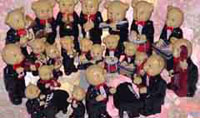Japanese Theatre
Above is just a small part of our gift-packed souvenir stamp-collection; inquire by email if the picture or subject of your interest is not here: we will be obliged to accomodate your wishes.
ここに掲載の写真は一部のみです。ご希望のジャンル、絵柄などございましたらお問い合わせください。
語源
語源はカブく(「傾く」が原義)の連用形からとされる。異様な振る舞いや装いをカブキといい、それをする人物をカブキ者と言った。歌舞伎の醍醐味はケレン味のある演出だといわれるのは、こういった背景にも由来する。
つまり歌舞伎というのは当て字であるが、歌い、舞い、伎(技芸、芸人)を意味する、この芸能を表現するのに適切な文字である。ただし当初はその発生史から伎ではなく妓の字が使われ、江戸時代には混用していたようであるが、明治時代以降、現在のように統一した表記になった。
歴史
1603年に北野天満宮で興行を行い、京都で評判となった出雲阿国(いずものおくに)が歌舞伎の発祥とされる。阿国は出雲大社の巫女であったとも河原者でもあったというが、定かなことは明らかでない。阿国はその時代の流行歌に合わせて、踊りを披露し、また、男装して当時のカブキ者のふるまいを取り入れて、当時最先端の演芸を生み出した。このころは能舞台などでおこなわれており、歌舞伎座の花道は(下手側が本花道、上手側が仮花道であることなども含め)ここから来ていると考えられる。
阿国が評判になると多くの模倣者が現れ、遊女が演じる遊女歌舞伎(女歌舞伎)や、前髪を剃り落としていない少年俳優たちが演じる若衆歌舞伎がおこなわれていたが、風紀を乱すとの理由から前者は1629年に禁止され、後者も売色の目的を兼ねる歌舞伎集団が横行したことなどから1652年に禁止され、現代に連なる野郎歌舞伎となった。そのため、歌舞伎においては男性役も女性役も、すべて男優が演じる。それは江戸時代の文化の爛熟のなかで洗練されて完成し、独特の美の世界を形成するに至っている。
歌舞伎は成立の過程から歌舞伎踊りと歌舞伎劇に分けられるともいう。前者は若衆歌舞伎までを言い、流行の歌に合わせた踊り(若衆歌舞伎はアクロバットなども見せていたとされる)を指す。また、その後に創作された踊り主体の演目も含める場合もある(歌舞伎舞踊の項目も参照)。一方、後者は江戸時代の町民に向けて製作されるうちに、現代に見られるような、舞踊的要素を備えた演劇となった。若衆歌舞伎が禁止される際に、幕府より「物真似狂言づくし」を義務付けられたことも演劇的発展の一因になった。つまり、幕府は舞踊主体の公演は売色などをともない、風紀上望ましくないと考えていた。演劇の内容は史実や物語、事件などを題材にして演じる芝居であり、歌舞伎狂言とも呼ばれる。これは現代における映画やテレビドラマに相当するだけでなく、さらにはワイドショー的な好奇心を満たす視覚・聴覚を動員したエンターテイメントとして形成されていった。それはいわゆる歌舞伎座、専用形式の劇場への移行と無関係ではない。引き幕によって時間を区切るという演出は物語に時の流れを自然に導入し、複雑な劇の展開を可能にした。また、客席を貫いて歌舞伎役者が登場・退場する花道によって他の演劇には見られないような2次元性(奥行き)を、またセリにより3次元性(高さ)を獲得し、高度な演劇へと進化した。
江戸時代の中期までは、上方で創作された歌舞伎狂言の比重は大きい。それは、上方が中心であった人形浄瑠璃から移植された演目の数からもわかる。その後、文化・文政期に鶴屋南北が江戸において多くの作品を創作している。また、江戸時代末期から明治時代初期にかけて、河竹黙阿弥が多数の作品を創作している。江戸時代後半から、上方と比較して、江戸の文化的発信地としての地位が向上したことがうかがえる。
このような歌舞伎狂言は、江戸時代には単に芝居と呼ばれることが多かったようである。
歌舞伎狂言の演劇的要素
現在伝承されている江戸時代に創作された歌舞伎狂言の演目は、大きく分けて人形浄瑠璃(文楽)の演目を移植したものと、歌舞伎狂言として創作されたものがある。人形浄瑠璃の演目を移植したものは丸本物と呼ばれる(義太夫狂言と呼ぶ場合も多いが、これは義太夫を用いる歌舞伎の称であり、意味するところは多少異なる)。この場合、舞台上手にぶん回し(回り舞台)を設置して義太夫の太夫と三味線による演奏が行われる。ただし、人形浄瑠璃ではすべての状況説明とせりふを太夫が語るのに対して、歌舞伎では状況説明を太夫が語り、役者がせりふを語るというような工夫がなされている。本来的に歌舞伎狂言として創作されたものは、基本的に下座での音楽が演劇を演出する。
演劇的な内容としては、歴史的事実を演劇化した時代物、その当時の世界を描写した(現在なら民放のテレビドラマに相当する)世話物などに分けられる。また、世界と呼ばれる約束事があり、演目の背景となっている物語の基本的な大枠が決まっていた。例えば「太平記の世界」、「平家物語の世界」、「義経記の世界」、「曾我物の世界」、「隅田川物の世界」などがあり、登場人物やその関係などは初めて見物する観客にとってもよく知っているなかで、観客は戯作者がどのようにストーリーを展開させるかを楽しむようになった。
江戸時代には歌舞伎狂言の公演は公許制度の下にあり、多くの時代において日の出から日没までにすべてを公演するという幕府によって定められた規則の下で公演された(理由は、日没後に大衆が集まることで不穏な政治行動に発展することを幕府が恐れたためとされる)。したがって、当時創作された演目は、休憩時間や舞台転換などの幕間を考慮しても、比較的長大なものが多い。観客にとっても歌舞伎狂言を観劇することは一日がかりの行楽であった。そのなかで時代物を好む観客や世話物を好む観客など、さまざまな観客を楽しませることが、歌舞伎狂言の公演に求められた。そのためにひとつの演目で、時代物と世話物が幕間をはさんで混在するような、複雑なストーリー展開をみせるものも少なくない。なお、今日では演目のすべてを上演することは多くない。人気のある場面を抜粋して上演することをみどり狂言と呼ぶ(「よりどりみどり」から来たとされる)。全編を通して上演することを通し狂言と呼ぶ。
歌舞伎音楽
歌舞伎音楽は、上手で行われるチョボ(義太夫)、下手で行われる下座音楽、舞台上で行われる出囃子に分けられる。
外題
歌舞伎の演目のタイトルを外題と呼ぶ(「芸題」からきたとする説が有力)。奇数が好まれ、たとえば「娘道成寺」には奇数とするため、「京鹿子」を付して「京鹿子娘道成寺」とする。ただし外題のほかに通称名があることが多く、外題は正式名のように扱われる。「都鳥廓白波(みやこどりながれのしらなみ)」が「忍ぶの惣太」と呼ばれたり、「八幡祭小望月賑(はちまんまつりよみやのにぎわい)」を「縮屋新助」と呼ぶなど。外題は奇数文字にするために、当て字などを用いるので、読み方が難解になっているものも多い。
Theatre of Japan
Traditional Japanese theatre includes kabuki, noh and bunraku.
1 Traditional Forms of Theatre
1.1 Kyogen
1.2 Kabuki
1.3 Bunraku
2 Modern theatre
2.1 Sho-Gekijo
2.2 Western Plays in Japan
3 Reference
Traditional Forms of Theatre
There are four major forms of traditional Japanese theatre that are famous around the world. These are Noh, Kyogen, Kabuki, and the Bunraku, or puppet theatre.
Kyogen
The earliest existing Kyogen scripts date from the 1500s. Kyogen was used as an intermission between Noh acts - it linked the theme of the Noh play with the modern world by means of farce and slapstick. Unlike Noh, the performers of Kyogen do not wear masks, unless their role calls for physical transformation.
Both men and women were allowed to perform Kyogen until the 1620s.
Kabuki
The most well-known form of Japanese theatre is of course, Kabuki. Perhaps its fame comes from the wild costumes and swordfights, which used real swords until the 1680s. Kabuki grew out of opposition to Noh - they wanted to shock the audience with more lively and timely stories. The first performance was in 1603.
Like Noh, however, over time Kabuki became not just performing in a new way, but a styalised art to be performed only a certain way.
As a matter of interest, the popular Gekidan Shinkansen, a theatrical troupe based in Tokyo today, insists it follows pure kabuki tradition be performing historical roles in a modern, noisy, and outlandish way - to shock the audience as kabuki intended, if you will. Whether or not they are kabuki, however, remains a matter of debate and personal opinion.
Bunraku
Puppets and Bunraku were used in Japanese theatre as early as the noh plays. Medieval records record the use of puppets actually in Noh plays. Puppets are three to four foot tall dolls that are manipulated by puppeteers in full view of the audience. The puppeteers controlling the legs and hands are dressed entirely in black, while the head puppeteer is wearing colorful clothing. Music and chanting is a popular convention of bunraku, and the shiamsen player is usually considered to be the leader of the production.
In modern media, a readily accessible example of bunraku is in Kitano Takeshi's 2002 movie, Dolls.
Modern theatre
Japanese modern drama in the early twentieth century, the 1910s, consisted of shingeki (experimental Western-style theater), which employed naturalistic acting and contemporary themes in contrast to the stylized conventions of Kabuki and Noh.
In the postwar period, there was a phenomenal growth in creative new dramatic works, which introduced fresh aesthetic concepts that revolutionized the orthodox modern theater. Challenging the realistic, psychological drama focused on "tragic historical progress" of the Western-derived shingeki, young playwrights broke with such accepted tenets as conventional stage space, placing their action in tents, streets, and open areas and, at the extreme, in scenes played out all over Tokyo.
Plots became increasingly complex, with play-within-a-play sequences, moving rapidly back and forth in time, and intermingling reality with fantasy. Dramatic structure was fragmented, with the focus on the performer, who often used a variety of masks to reflect different personae.
Playwrights returned to common stage devices perfected in Noh and Kabuki to project their ideas, such as employing a narrator, who could also use English for international audiences. Major playwrights in the 1980s were Kara Joro, Shimizu Kunio, and Betsuyaku Minoru, all closely connected to specific companies. In the 1980s, stagecraft was refined into a more sophisticated, complex format than in the earlier postwar experiments but lacked their bold critical spirit.
Suzuki Tadashi's Togo troupe developed a unique kind of "method acting," integrating avant-garde concepts with classical Noh and Kabuki devices, an approach that became a major creative force in Japanese and international theater in the 1980s. Another highly original East-West fusion occurred in the inspired production Nastasya, taken from Dostoevsky's The Idiot, in which Bando Tamasaburo, a famed Kabuki onnagata (female impersonator), played the roles of both the prince and his fiancee.
Sho-Gekijo
The 1980's also encouraged the creation of the Sho-Gekijo, or literally, little theatre. This usually meant amateur theatrical troupes making plays designed to be seen by anyone and everyone - not necessarily as meaningful in nature as they were simply entertaining.
Some of the more philosophical playwrights and directors of that time which are still active today are Noda Hideki, Kogami Shoji and Keralino Sandorovich (a pen name for a Japanese playwright).
Popular sho-gekijo theatrical troupes include Nylon 100, Gekidan Shinkansen, Tokyo Sunshine Boys, and Halaholo Shangrila.
Western Plays in Japan
Many Western plays, from those of the Ancient Greek theatre to William Shakespeare and from those of Fyodor Dostoevsky to Samuel Beckett, were performed in Tokyo. An incredible number of performances, perhaps as many as 3,000, were given each year, making Tokyo one of the world's leading theatrical centers.
The opening of the replica of the Globe Theatre was celebrated by importing an entire British company to perform all of Shakespeare's historical plays, while other Tokyo theaters produced other Shakespearean plays including various new interpretations of Hamlet and King Lear.
Yukio Ninagawa is an internationally acclaimed Japanese director and playwright who often turns to elements of Shakespeare for inspiration. In 1995 he performed the "Shakespeare Tenpo 12Nen," an interpretation of the wildly popular British theatre Shakespeare Condensed all of Shakespeare's plays in two hours. Famous actors such as Natsuki Mari and Karasawa Toshiaki.
The above explanation comes from  出典: フリー百科事典"ウィキペディア"
出典: フリー百科事典"ウィキペディア"

